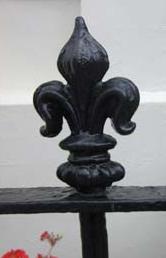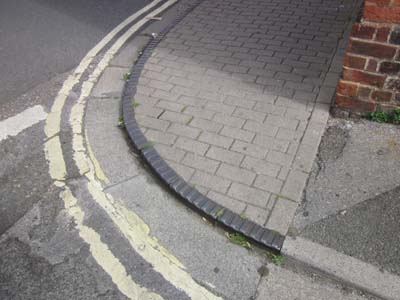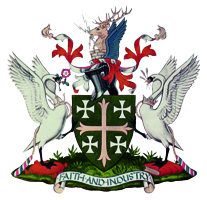The Holt, 2 Oxford Road, an Abingdon house built in about 1920 and demolished in about 1964
Today, The Holt is a small estate of houses and flats off the Oxford Road in Abingdon, just on the town side of where the Victorian workhouse stood. But the 1934 Electoral Roll gave the name of No. 2 Oxford Road as ‘The Holt’, and in the 1939 Register the Oxford Road numbers started at No. 2 with its occupant, Charles Kingerlee. ‘The Holt’ was originally a single house, its grounds occupied the same site as the estate does now, and No. 2 Oxford Road is nowhere to be seen today.
This raised three questions. When was the individual house, ‘The Holt’, built? What did it look like? When was it demolished?

The Holt estate looking east(© Barry Taylor 2025)


Two views of ‘The Holt’
Photographers and dates unknown, photographs kindly provided by Henry Hayward, a grandson of the first owner of the original house, Mrs Mary Constance Matilda Hayward, widow of Dr Milward Hayward.
One of the Doctor’s sons wrote, “The wooden “hut” (seen in the first photo above, to the right of the house) was given to us by Uncle Tom (H. A. T. Fairbank) and Aunt Kathleen as a playroom.
History of the Land
Going back in time in Abingdon, there was a very significant manor known as Fitzharris, although the spelling varied over time. However, the estate was sold off in parcels of land, including the plot on which ‘The Holt’ was eventually built.
The 1874 Sale
On Wednesday, 21st October 1874, Lot 1 of the ‘Fitzharris’ Estate was sold for £22,000. ‘The Holt’ area in question had been part of the Fitzharris Estate and Plot 34, listed as ‘Union Field’, bordered the Vineyard. This was marked as arable.
The 1912 Sale
The Fitzharris Estate, listed as the property of the late J Heber Clarke, a former Mayor of Abingdon, was again up for sale. The auction was held on 12 June 1912 in The Lion Hotel, Abingdon.
Plot 86, comprising just over three acres, was described as the ‘Oxford Road Paddock’. Its tenant was a Mr J G T West, a well-known local architect who lived in ‘The Knowl’ in Stert Street’. The sales particulars include the following text:
“The Paddocks extend to the Vineyard at the junction of the Radley and Oxford Roads, from which the (Fitzharris) Residence may be approached by a footpath. As the Town extends…. the valuable Vineyard frontages may be developed without detriment to the remainder of the Residential portion of the Estate.”
The 1914 Sale
On Monday, 8th June 1914, two plots of the Fitzharris Estate, then owned by the Rev. William Newcombe Blakeney, were put up for auction again, also at the Lion Hotel, Abingdon. Lot 1 would become the site of ‘The Holt’. It was described as ‘Valuable Freehold Accommodation and Building Land centrally situated on the West side of the Oxford Road‘ and as ‘ripe for immediate development’. Dr Milward Cecil Hayward became the successful purchaser on 18 November 1914.

Dr Milward Hayward

Sale completion statement 1914
Images kindly provided by Henry Hayward
He was one of the most distinguished members of the Abingdon community. In 1902, he had purchased 65 Stert Street and set up the Stert Street Surgery which is still in operation today. He made his rounds in a pony and trap but, from 1909 onwards, he also owned a car, probably a single-cylinder Cadillac, imported by a distributor from the U.S.

Dr Hayward with his wife and two eldest children in 65 Stert Street (in about 1904)

Dr Hayward and his car
Images kindly provided by Henry Hayward
Dr Hayward intended to set up a new home for his family on the land he had purchased but, with the arrival of the First World War, everything changed. He volunteered at the start of the war and joined one of the Home Counties Field Ambulances. On 11 May 1915, at Ypres, he was severely wounded, and he died of pneumonia on 23 August 1916 in hospital in Brighton. Further details can be found in the Abingdon Blog: Founder of Abingdon Surgery remembered | Abingdon Blog

Dr Hayward’s grave in Spring Road cemetery, Abingdon.(© Barry Taylor 2024)

Dr Hayward’s name on the Abingdon War Memorial (© Barry Taylor 2024)

Enlarged view of part of the upper inscription on the War Memorial showing Dr Hayward’s name(© Barry Taylor 2024)
Building ‘The Holt’
Dr Hayward’s wife, Mrs Mary Constance Hayward, was involved in planning the move to the new house while her husband was away in France. They had previously chosen ‘The Holt’ to be its name. After his death, she continued this project with an award-winning design by Arthur (P.R.I.B.A.) and K. M. B. Cross (F.R.I.B.A.), father and son, the former a friend of the doctor. ‘Cross and Cross’ were the architects on a number of sites in London and elsewhere, usually specialising in large public swimming pools and baths.
‘The Holt’ stood in two acres of land, but, as one of the doctor’s sons later wrote, “The Holt was designed to its then size so as to be small enough to qualify for a government grant.” The Chamberlain Act of 1923 provided a subsidy to builders to encourage more house building. This included houses that were to be privately owned and occupied, provided that there was a “proved” local need, so ‘The Holt’ may have qualified for this.
‘The Holt’ was built shortly after the end of the First World War and became the residence of the Hayward family. Mrs Hayward put the 65 Stert Street surgery site up for auction on Wednesday20 July 1921 at the Golden Cross Hotel, Oxford, and the Hayward family subsequently moved to ‘The Holt’.
The Location of ‘The Holt’
a. Before
A 1920 aerial photograph shows the empty site of ‘The Holt’, in the foreground, next to the Union Workhouse.at: https://britainfromabove.org.uk/en/image/EPW000888 – look near the top left-hand corner at the edge of the built-up area.
b. After

Extract of 1938 OS 25 inch map(Reproduced with the permission of the National Library of Scotland. https://maps.nls.uk/)
Map link: Abingdon 1938 Ordnance Survey 25 inch
This census of ‘The Holt’ taken on 19 June 1921 shows the following:
| Name | Relationship to head | Age | Birthplace | Occupation |
| Constance Mary Hayward | Head | 51 | London | Home Duties |
| Edwin William Hayward | Son | 18 | Abingdon | Medical Student |
| Constance Marian Hayward | Daughter | 9 | Abingdon | |
| Mary Gertrude Edwards | Sister | 55 | Twickenham, Middx. | None |
| Pearly Everell | Servant | 46 | Spetchley, Worcs. | Gardener |
| Constance Ellen Barker | Visitor | 57 | London | None |
Mrs Constance Mary Hayward is also shown on the Electoral Register as living in ‘The Holt’ for some years. Later, her son wrote, “My mother sold it in 1934 when we were all working and she was unhappy in Abingdon.”
Second Resident – Mr Charles Kingerlee
The next occupant was Mr Charles Kingerlee. Mr Kingerlee (also known as Carl) was Henry Stephen Kingerlee’s son. He worked for William Morris (Lord Nuffield), the Cowley car manufacturer, for many years and was his private secretary until Lord Nuffield’s death in 1963. Mr Kingerlee himself lived at ‘The Holt’ until 1955.
Sources, including the 1939 Register, show the seven occupants of 2 Oxford Road a.k.a. ‘The Holt’ as follows:
| Surname | Forename | Age | Occupation |
| Kingerlee | Charles (Carl) Thomson | 38 | Assistant Works Superintendent |
| Kingerlee | Emily Eileen | 39 | Unpaid Domestic Duties |
| Three children | details not disclosed | ||
| Perris | Winifred R | 18 | Paid Domestic Worker |
| Harris | Fred | 63 | Gardener |
In October 2024, the author of this article had a conversation with a 95-year-old local resident who still remembered ‘The Holt’ and spoke of the daughters riding horses there.
Third resident – Mr Denis Gibson
Mr Gibson, with his wife, Joyce, lived at No. 2 Oxford Road ‘The Holt’ from 1956 to 1963.
On 1 March 1963 Mr Gibson applied for planning permission to build an estate of houses on the site. These were completed by N Blake Ltd of Didcot and advertised in the Abingdon Herald on 18 June 1964. The new estate was described as “Close to the Town Centre” offering “An opportunity to own your own home in this popular town at reasonable cost”. The estate was labelled as “No. 2 Oxford Road“. The plan included freehold “Terraced Houses to modern design” with a completion date from late spring 1965 and priced from £3,250 to £3,650, the sales to be managed by “Adkin, Belcher and Bowen”.
Link to 1964 plans: The Holt Applications List

Proposed Plan – August 1964(© 2025 Vale of White Horse District Council)
Some properties are freehold, some are leasehold with 1,000-year leases and the 1967 Electoral Roll shows that most of them were occupied by that date.
‘The Holt’ was an outstanding example of award-winning architecture on a two-acre plot of land. Sadly, it only existed from about 1920 until about 1964. In that time, it was home to some significant families in Abingdon.
Acknowledgements
As a building immediately next to the site of the Abingdon Workhouse, ‘The Holt’ was included in the research carried out by the Workhouse History Group many of whom have contributed information about it.
Many thanks to all who have helped with information about the history of ‘The Holt, especially including:
- Henry Hayward and Jenny Burgon of the Hayward family who have provided so much help in the form of documents, pictures and memories. From the Abingdon community, amongst others: • Mike Evans, the Fitzharris Estate Residents Association ,(www.fitzmanorestate.org.uk) • Hester Hand, Abingdon Civic Society • Jackie Smith, Abingdon Honorary Town Archivist • Roger Thomas, the Abingdon Area Archaeology and History Society, https://www.aaahs.org.uk/ • Liz Woolley, Oxford Historian • Jason Oliver, architect • Barry Taylor and other members of the Workhouse History Group
© AAAHS and contributors 2025




 This month the Abingdon Silver Group presented Abingdon Museum with a sterling silver plaque bearing their own mark, made with two punches in different sizes.
This month the Abingdon Silver Group presented Abingdon Museum with a sterling silver plaque bearing their own mark, made with two punches in different sizes.

 (© From AAAHS photographic collection. Copyright owner unidentified.}
(© From AAAHS photographic collection. Copyright owner unidentified.}












![Figure 13 Design from Cottingham[4]](https://www.abingdon.gov.uk/wp-content/uploads/2020/11/u943_fig.13.jpg)
































